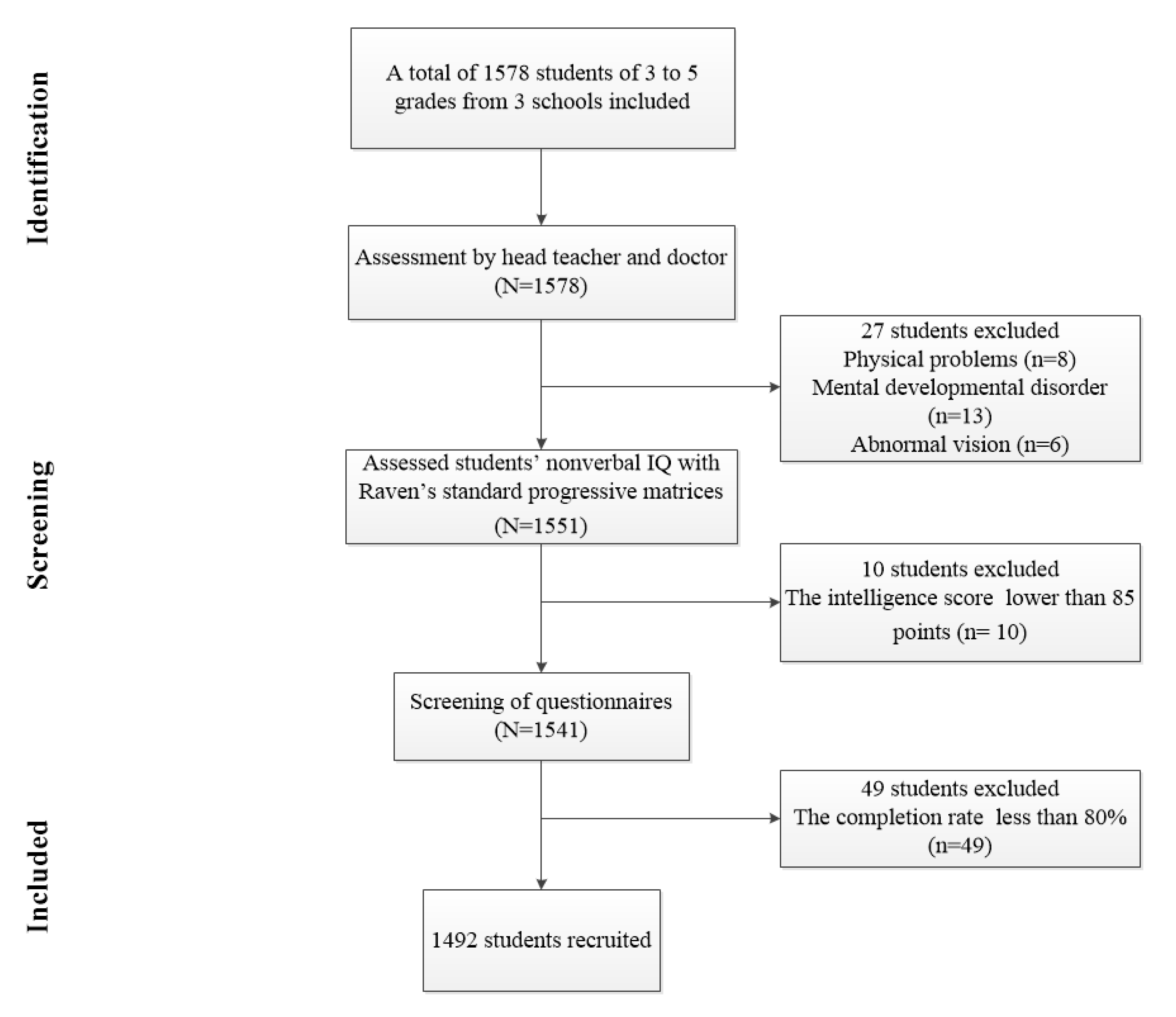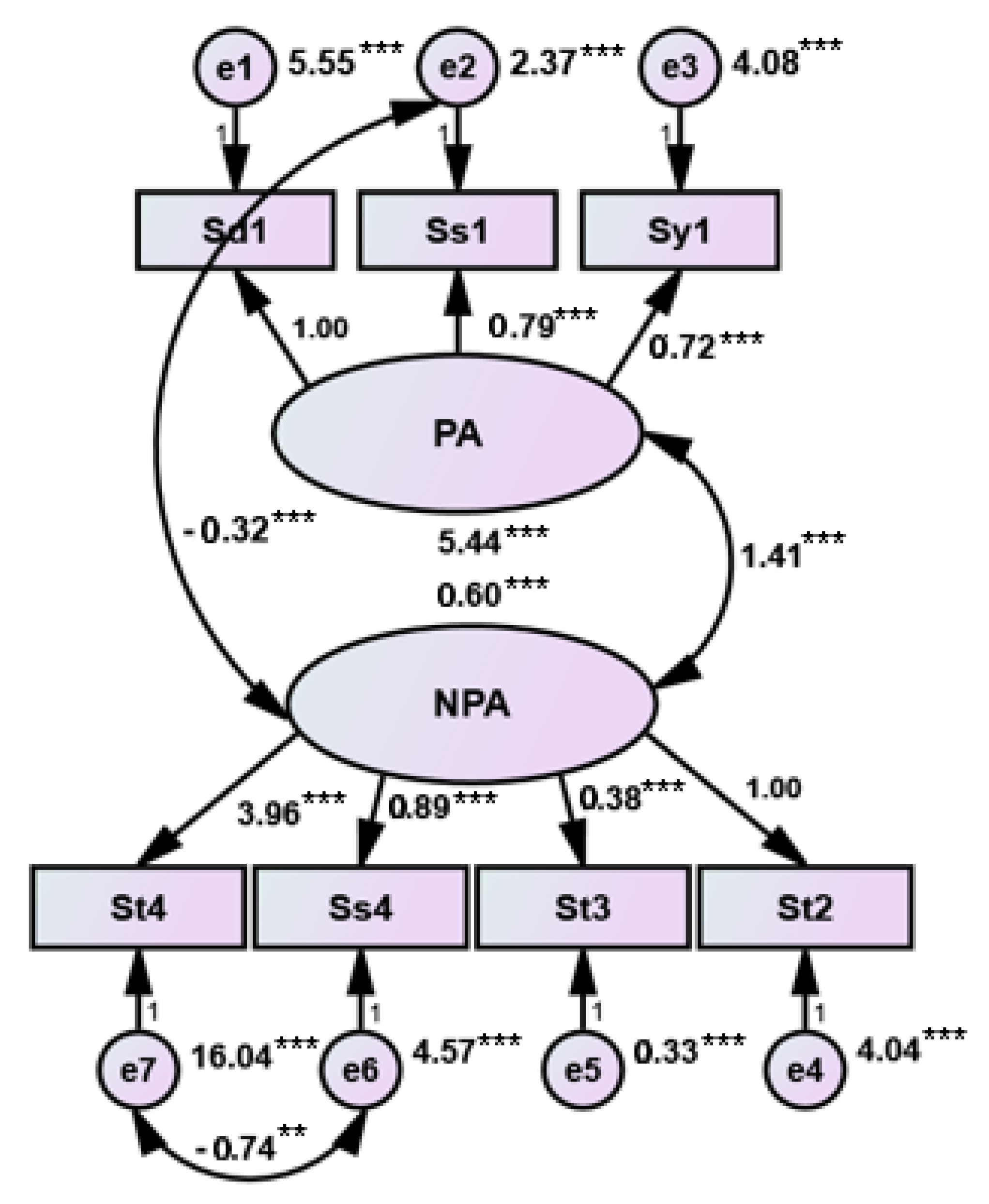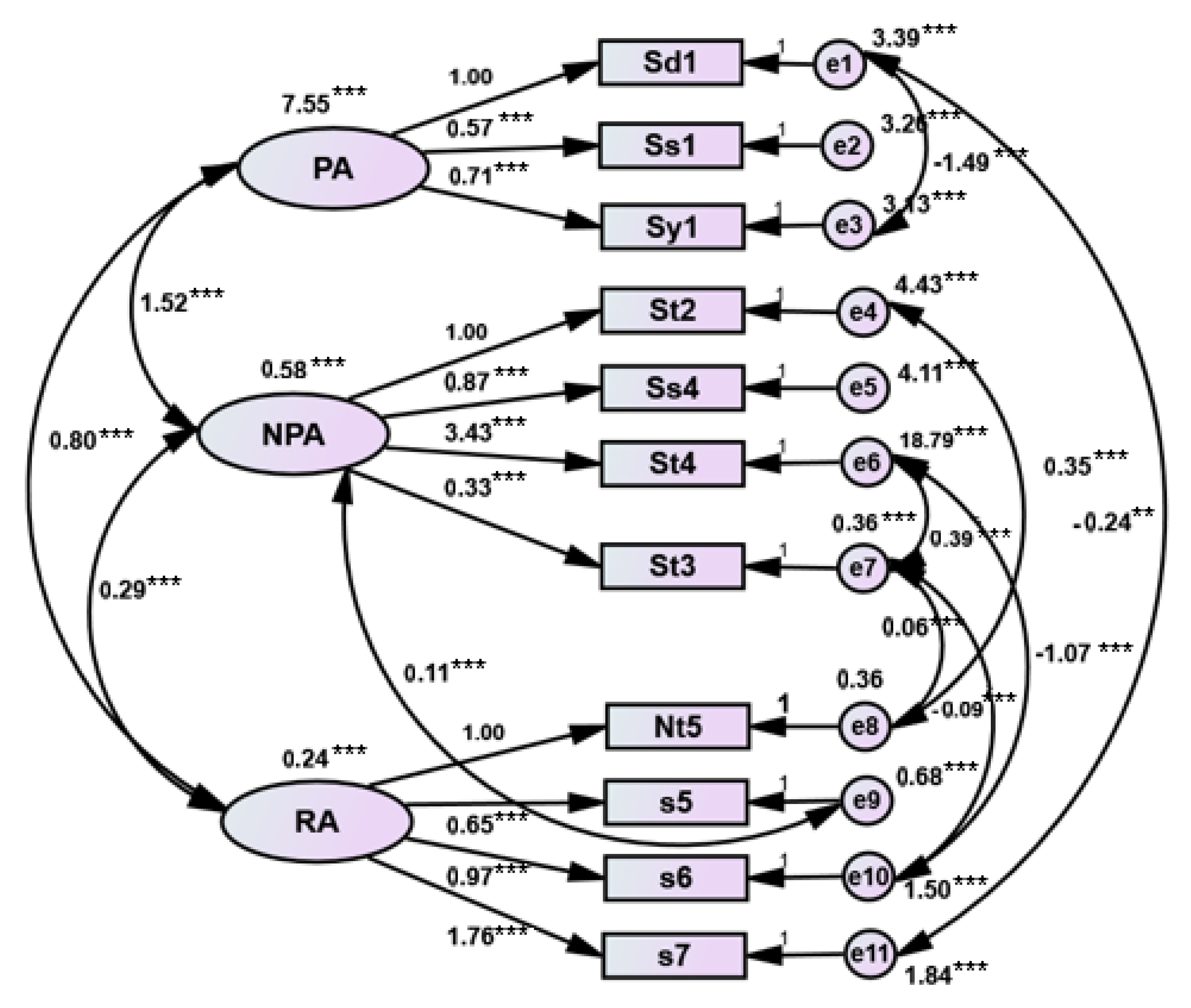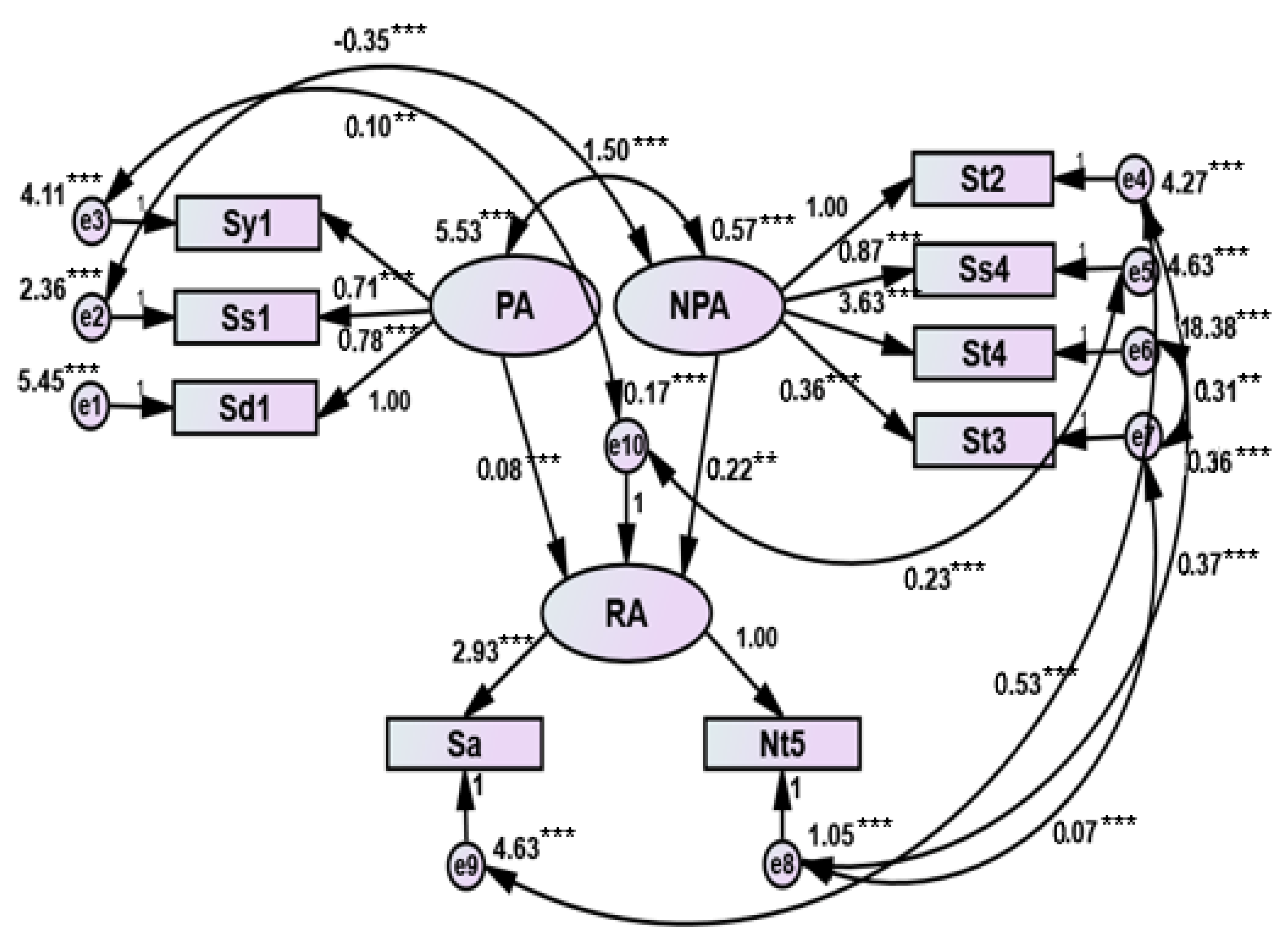The Reliability and Validity of an Assessment Tool for Developmental Dyslexia in Chinese Children
Abstract
:1. Introduction
2. Materials and Methods
2.1. Participants
2.2. Procedures
2.3. Instruments
2.3.1. Raven’s Standard Progressive Matrices
2.3.2. Character Recognition Measure and Assessment Scale for Primary School Children
2.3.3. Chinese Reading Ability Test (CRAT)
- Phonological Awareness Subscale
- Morphological Awareness Subscale
- Rapid Automatized Naming Subscale
- Orthographic Awareness Subscale
- Reading Ability Subscale
2.4. Statistical Methods
3. Results
3.1. Reliability Statistics
3.1.1. Test–retest Reliability
3.1.2. Internal Consistency Reliability
3.2. Validity Statistics
3.2.1. Discriminant Validity
3.2.2. Content Validity
3.2.3. Confirmatory Factor Analyses (CFA) of the CRAT
4. Discussion
5. Conclusions
Author Contributions
Funding
Acknowledgments
Conflicts of Interest
References
- APA. Diagnostic and Statistical Manual of Mental Disorders, 5th ed.; DSM-5; American Psychiatric Publishing: Washington, DC, USA, 2013. [Google Scholar]
- Lyon, G.R.; Shaywitz, S.E.; Shaywitz, B.A. A definition of dyslexia. Ann. Dyslexia 2003, 53, 1–14. [Google Scholar] [CrossRef]
- Shaywitz, S.E.; Morris, R.; Shaywitz, B.A. The education of dyslexic children from childhood to young adulthood. Annu. Rev. Psychol. 2008, 59, 451–475. [Google Scholar] [CrossRef] [Green Version]
- Ziegler, J.C.; Goswami, U. Reading acquisition, developmental dyslexia, and skilled reading across languages: A psycholinguistic grain size theory. Psychol. Bull. 2005, 131, 3–29. [Google Scholar] [CrossRef] [Green Version]
- Lee, L.W. Development and validation of a reading-related assessment battery in Malay for the purpose of dyslexia assessment. Ann. Dyslexia 2008, 58, 37–57. [Google Scholar] [CrossRef] [PubMed]
- Becker, N.; Vasconcelos, M.; Oliveira, V.; Santos, F.C.D.; Bizarro, L.; Almeida, R.M.M.D.; Salles, J.F.D.; Carvalho, M.R.S. Genetic and environmental risk factors for developmental dyslexia in children: Systematic review of the last decade. Dev. Neuropsychol. 2017, 42, 423–445. [Google Scholar] [CrossRef] [PubMed]
- Ghisi, M.; Bottesi, G.; Re, A.M.; Cerea, S.; Mammarella, I.C. Socioemotional Features and Resilience in Italian University Students with and without Dyslexia. Front. Psychol. 2016, 7, 478. [Google Scholar] [CrossRef] [PubMed] [Green Version]
- McLaughlin, M.J.; Speirs, K.E.; Shenassa, E.D. Reading disability and adult attained education and income: Evidence from a 30-year longitudinal study of a population-based sample. J. Learn. Disabil. 2014, 47, 374–386. [Google Scholar] [CrossRef] [PubMed]
- Cavalli, E.; Colé, P.; Leloup, G.; Poracchia-George, F.; Sprenger-Charolles, L.; El Ahmadi, A. Screening for Dyslexia in French-Speaking University Students: An Evaluation of the Detection Accuracy of the Alouette Test. J. Learn. Disabil. 2018, 51, 268–282. [Google Scholar] [CrossRef] [Green Version]
- Kaltner, S.; Jansen, P. Mental rotation and motor performance in children with developmental dyslexia. Res. Dev. Disabil. 2014, 35, 741–754. [Google Scholar] [CrossRef]
- Shu, H.; McBride-Chang, C.; Wu, S.; Liu, H. Understanding Chinese developmental dyslexia: Morphological awareness as a core cognitive construct. J. Educ. Psychol. 2006, 98, 122–133. [Google Scholar] [CrossRef] [Green Version]
- Li, H.; Shu, H.; McBride-Chang, C.; Liu, H.Y.; Xue, J. Paired associate learning in Chinese children with dyslexia. J. Exp. Child Psychol. 2009, 103, 135–151. [Google Scholar] [CrossRef] [PubMed]
- Ma, Y.; Wang, E.; Yuan, T.; Zhao, G.X. Location negative priming effects in children with developmental dyslexia: An event-related potential study. Res. Dev. Disabil. 2016, 55, 88–99. [Google Scholar] [CrossRef] [PubMed]
- Zhang, J.; McBride-Chang, C. Diversity in Chinese Literacy Acquisition. Writ. Syst. Res. 2011, 3, 87–102. [Google Scholar] [CrossRef]
- McBride, C.; Wang, Y.; Cheang, L.M.-L. Dyslexia in Chinese. Curr. Dev. Disord. Rep. 2018, 5, 217–225. [Google Scholar] [CrossRef]
- Ho, C.S.-H.; Chan, D.W.-O.; Tsang, S.-M.; Lee, S.-H. The cognitive profile and multiple-deficit hypothesis in Chinese developmental dyslexia. Dev. Psychol. 2002, 38, 543–553. [Google Scholar] [CrossRef]
- Frost, R. Towards a universal model of reading. Behav. Brain Sci. 2012, 35, 263–279. [Google Scholar] [CrossRef] [Green Version]
- Ho, C.S.-H.; Chan, D.W.-O.; Lee, S.-H.; Tsang, S.-M.; Luan, V.H. Cognitive profiling and preliminary subtyping in Chinese developmental dyslexia. Cognition 2004, 91, 43–75. [Google Scholar] [CrossRef]
- Skeide, M.A.; Kirsten, H.; Kraft, I.; Schaadt, G.; Müller, B.; Neef, N.; Brauer, J.; Wilcke, A.; Emmrich, F.; Boltze, J.; et al. Genetic dyslexia risk variant is related to neural connectivity patterns underlying phonological awareness in children. Neuroimage 2015, 118, 414–421. [Google Scholar] [CrossRef]
- Saksida, A.; Iannuzzi, S.; Bogliotti, C.; Chaix, Y.; Démonet, J.-F.; Bricout, L.; Billard, C.; Nguyen-Morel, M.-A.; Le Heuzey, M.-F.; Soares-Boucaud, I.; et al. Phonological skills, visual attention span, and visual stress in developmental dyslexia. Dev. Psychol. 2016, 52, 1503–1516. [Google Scholar] [CrossRef] [Green Version]
- McBride-Chang, C.; Shu, H.; Zhou, A.; Wat, C.; Wagner, R. Morphological Awareness Uniquely Predicts Young Children’s Chinese Character Recognition. J. Educ. Psychol. 2003, 95, 743–751. [Google Scholar] [CrossRef] [Green Version]
- Norton, E.S.; Wolf, M. Rapid automatized naming (RAN) and reading fluency: Implications for understanding and treatment of reading disabilities. Annu. Rev. Psychol. 2012, 63, 427–452. [Google Scholar] [CrossRef] [PubMed] [Green Version]
- Bishop, D.V.M.; McDonald, D.; Bird, S.; Hayiou-Thomas, M.E. Children who read words accurately despite language impairment: Who are they and how do they do it? Child Dev. 2009, 80, 593–605. [Google Scholar] [CrossRef] [PubMed] [Green Version]
- McArthur, G.; Castles, A. Phonological processing deficits in specific reading disability and specific language impairment: Same or different? J. Res. Read. 2013, 36, 280–302. [Google Scholar] [CrossRef]
- Tzeng, Y.-L.; Hsu, C.-H.; Lin, W.-H.; Lee, C.-Y. Impaired Orthographic Processing in Chinese Dyslexic Children: Evidence From the Lexicality Effect on N400. Sci. Stud. Read. 2017, 22, 85–100. [Google Scholar] [CrossRef]
- McBride-Chang, C.; Cho, J.-R.; Liu, H.; Wagner, R.K.; Shu, H.; Zhou, A.; Cheuk, C.S.M.; Muse, A. Changing models across cultures: Associations of phonological awareness and morphological structure awareness with vocabulary and word recognition in second graders from Beijing, Hong Kong, Korea, and the United States. J. Exp. Child Psychol. 2005, 92, 140–160. [Google Scholar] [CrossRef]
- Shu, H.; Chen, X.; Anderson, R.C.; Wu, N.; Xuan, Y. Properties of school Chinese: Implications for learning to read. Child Dev. 2003, 74, 27–47. [Google Scholar] [CrossRef]
- Silverman, R.D.; Speece, D.L.; Harring, J.R.; Ritchey, K.D. Fluency Has a Role in the Simple View of Reading. Sci. Stud. Read. 2013, 17, 108–133. [Google Scholar] [CrossRef]
- Fuchs, L.S.; Fuchs, D.; Hosp, M.K.; Jenkins, J.R. Oral Reading Fluency as an Indicator of Reading Competence: A Theoretical, Empirical, and Historical Analysis. Sci. Stud. Read. 2001, 5, 239–256. [Google Scholar] [CrossRef]
- Kendeou, P.; van den Broek, P.; Helder, A.; Karlsson, J. A Cognitive View of Reading Comprehension: Implications for Reading Difficulties. Learn. Disabil. Res. Pract. 2014, 29, 10–16. [Google Scholar] [CrossRef]
- Babayigit, S.; Stainthorp, R. Modeling the Relationships Between Cognitive-Linguistic Skills and Literacy Skills: New Insights From a Transparent Orthography. J. Educ. Psychol. 2011, 103, 169–189. [Google Scholar] [CrossRef] [Green Version]
- Gardner, P. Diagnosing Dyslexia in the Classroom: A Three-Stage Model; Whurr: London, UK, 2008; pp. 83–100. [Google Scholar] [CrossRef]
- Lin, O.; Wang, Z.; Meng, X. Visual Perceptual Learning in Chinese Developmental Dyslexia. Acta Psychol. Sin. 2013, 45, 762–772. [Google Scholar] [CrossRef]
- Raven, J.C. Raven Progressive Matrices; Springer US: Boston, MA, USA, 2003; pp. 223–237. [Google Scholar] [CrossRef]
- Xiaolin, W.; Baoping, T. Chinese Character Recognition Test Battery and Assessment Scale for Primary School Children; Shanghai Education Press: Shanghai, China, 1993; (Original work published in Chinese). [Google Scholar]
- Cheng, Y.; Zhang, J.; Li, H.; Wu, X.; Liu, H.; Dong, Q.; Li, L.; Nguyen, T.; Zheng, M.; Zhao, Y.; et al. Growth of Compounding Awareness Predicts Reading Comprehension in Young Chinese Students: A Longitudinal Study From Grade 1 to Grade 2. Read. Res. Q. 2016, 52, 91–104. [Google Scholar] [CrossRef]
- Yang, X.; Peng, P.; Meng, X. Contributions of Basic Cognitive Processing to Chinese Reading: The Mediation Effect of Basic Language Processing. Front. Psychol. 2018, 9, 2670. [Google Scholar] [CrossRef] [PubMed] [Green Version]
- Cheung, W.; Tse, S.; Lam, W.I.J.; Loh, K. Progress in International Reading Literacy Study 2006 (PIRLS): Pedagogical correlates of fourth-grade students in Hong Kong. J. Res. Read. 2009, 32, 293–308. [Google Scholar] [CrossRef]
- Yeung, P.-S.; Ho, C.; Chan, D.; Chung, K.; Wong, Y.-k. A model of reading comprehension in Chinese elementary school children. Learn. Individ. Differ. 2013, 25, 55–66. [Google Scholar] [CrossRef]
- Liu, P.; McBride-Chang, C. What Is Morphological Awareness? Tapping Lexical Compounding Awareness in Chinese Third Graders. J. Educ. Psychol. 2010, 102, 62–73. [Google Scholar] [CrossRef]
- Cheung, H.; Chung, K.; Wong, S.; McBride-Chang, C.; Penney, T.; Ho, C. Speech Perception, Metalinguistic Awareness, Reading, and Vocabulary in Chinese-English Bilingual Children. J. Educ. Psychol. 2010, 102, 367–380. [Google Scholar] [CrossRef] [Green Version]
- Xue, J.; Shu, H.; Li, H.; Li, W.; Tian, X. The stability of literacy-related cognitive contributions to Chinese character naming and reading fluency. J. Psycholinguist. Res. 2013, 42, 433–450. [Google Scholar] [CrossRef]
- Yeung, P.-S.; Ho, C.; Wong, Y.-K.; Chan, D.; Chung, K.; Lo, L.-Y. Longitudinal predictors of Chinese word reading and spelling among elementary grade students. Appl. Psycholinguist. 2013, 34, 1245–1277. [Google Scholar] [CrossRef] [Green Version]
- Zhou, Y.; McBride-Chang, C.; Law, A.B.-Y.; Li, T.; Cheung, A.C.-Y.; Wong, A.M.Y.; Shu, H. Development of reading-related skills in Chinese and English among Hong Kong Chinese children with and without dyslexia. J. Exp. Child Psychol. 2014, 122, 75–91. [Google Scholar] [CrossRef]
- Aleksic, J.; Zvekic-Svorcan, J.; Vujasinovic Stupar, N.; Jeremic, I.; Grgurevic, A. Cross-cultural validation of the Modified Falls Efficacy Scale in Serbian community-dwelling women at risk for osteoporotic fracture. Menopause 2018, 25, 444–450. [Google Scholar] [CrossRef] [PubMed]
- Lance, C.; Butts, M.; Michels, L. The Sources of Four Commonly Reported Cutoff Criteria: What Did They Really Say? Organ. Res. Methods 2006, 9, 202–220. [Google Scholar] [CrossRef]
- Kline, P. Handbook of Psychological Testing, 2nd ed.; Routledge: London, UK, 2000. [Google Scholar]
- Leong, C.; Tse, S.; Loh, K.; Hau, K.-T. Text Comprehension in Chinese Children: Relative Contribution of Verbal Working Memory, Pseudoword Reading, Rapid Automatized Naming, and Onset-Rime Phonological Segmentation. J. Educ. Psychol. 2008, 100, 135–149. [Google Scholar] [CrossRef]
- Chik, P.P.-M.; Ho, C.S.-H.; Yeung, P.-S.; Wong, Y.-K.; Chan, D.W.-O.; Chung, K.K.-H.; Lo, L.-Y. Contribution of discourse and morphosyntax skills to reading comprehension in Chinese dyslexic and typically developing children. Ann. Dyslexia 2012, 62, 1–18. [Google Scholar] [CrossRef] [Green Version]
- Byrne, B.M. Structural Equation Modeling with AMOS: Basic Concepts, Applications, and Programming, 1st ed.; Psychology Press: New York, NY, USA, 2001; Volume 20, pp. 1–418. [Google Scholar]




| Test Score M (P25 ~ P75) | Retest Score M (P25 ~ P75) | R | |
|---|---|---|---|
| Phonological Awareness | 24.00 (21.00 ~ 28.00) | 25.00 (19.00 ~ 27.00) | 0.599 ** |
| Morphological Awareness | 3.28 (2.80 ~ 3.93) | 4.00(2.89 ~ 4.88) | 0.790 ** |
| RAN | 2.21 (1.98 ~ 2.55) | 2.23(1.93 ~ 2.51) | 0.757 ** |
| Orthographic Awareness | 24.82 (21.43 ~ 26.24) | 25.35(23.27 ~ 29.96) | 0.442 ** |
| Reading Ability | 12.48 (11.19 ~ 14.86) | 11.92(9.77 ~ 14.04) | 0.652 ** |
| Total Score | 80.45 (67.20 ~ 87.64) | 84.22(72.05 ~ 90.41) | 0.671 ** |
| Subscale | PA | NPA | RA | Total | Cronbach’s Alpha |
|---|---|---|---|---|---|
| PA | 1.000 | - | - | 0.869 ** | 0.76 |
| NPA | 0.448 ** | 1.000 | - | 0.725 ** | 0.42 |
| RA | 0.399 ** | 0.418 ** | 1.000 | 0.684 ** | 0.50 |
| Total | 0.869 ** | 0.725 ** | 0.684 ** | 1.000 | 0.75 |
| Dyslexia (n = 57) | Control (n = 57) | Z * | p | |
|---|---|---|---|---|
| PA | ||||
| Sd1 | 9.00 (5.50 ~ 11.00) | 12.00 (10.00 ~ 12.00) | −4.65 | <0.001 |
| Ss1 | 9.00 (7.00 ~ 10.00) | 10.00 (9.00 ~ 11.00) | −4.52 | <0.001 |
| Sy1 | 8.00 (5.00 ~ 9.00) | 10.00 (8.00 ~ 11.00) | −4.43 | <0.001 |
| MA | ||||
| T2 | 162.00 (147.50 ~ 186.50) | 135.00 (120.00 ~ 160.00) | −4.07 | <0.001 |
| S2 | 9.00 (9.00 ~ 10.00) | 10.00 (10.00 ~ 10.00) | −5.05 | <0.001 |
| St2 | 3.41 (2.90 ~ 3.99) | 4.44 (3.80 ~ 4.87) | −5.01 | <0.001 |
| RAN | ||||
| T3 | 16.50 (14.50 ~ 19.25) | 13.50 (12.00 ~ 15.75) | −4.67 | <0.001 |
| S3 | 40.00 (39.50 ~ 40.00) | 40.00 (40.00 ~ 40.00) | −1.48 | >0.05 |
| St3 | 2.35 (2.07 ~ 2.76) | 2.96 (2.54 ~ 3.29) | −4.75 | <0.001 |
| OA | ||||
| Ss4 | 15.00 (14.00 ~ 16.50) | 17.00 (16.00 ~ 18.00) | −3.94 | <0.001 |
| t4 | 32.00 (27.50 ~ 40.00) | 30.00 (25.00 ~ 34.00) | −2.33 | <0.05 |
| s4 | 11.00 (10.00 ~ 11.00) | 11.00 (11.00 ~ 12.00) | −3.06 | <0.001 |
| St4 | 10.00 (7.90 ~ 11.69) | 11.79 (9.55 ~ 14.07) | −2.87 | <0.001 |
| RA | ||||
| N1 | 180.00 (152.00 ~ 211.00) | 221.00 (200.50 ~ 247.50) | −4.88 | <0.001 |
| T5 | 100.00 (80.50 ~ 118.50) | 81.00 (70.50 ~ 86.00) | −4.85 | <0.001 |
| N2 | 290.00 (288.00 ~ 292.00) | 293.00 (291.00 ~ 294.00) | −4.66 | <0.001 |
| Nt5 | 2.94 (2.42 ~ 3.57) | 3.64 (3.39 ~ 4.17) | −4.96 | <0.001 |
| Sa | 10.00 (8.00 ~ 12.00) | 11.00 (10.00 ~ 12.00) | −2.16 | <0.005 |
| s5 | 2.00 (2.00 ~ 3.00) | 2.00 (2.00 ~ 3.50) | −1.07 | >0.05 |
| s6 | 4.00 (3.00 ~ 5.00) | 4.00 (3.50 ~ 5.00) | −1.75 | >0.05 |
| s7 | 4.00 (2.00 ~ 4.00) | 4.00 (3.00 ~ 5.00) | −2.17 | <0.05 |
| p | χ2/df | GFI | RMSEA | AGFI | NFI | CFI | IFI | |
|---|---|---|---|---|---|---|---|---|
| Model 1 | 0.307 | 1.163 | 0.995 | 0.011 | 0.987 | 0.975 | 0.996 | 0.996 |
| Model 2 | 0.137 | 1.271 | 0.991 | 0.014 | 0.982 | 0.944 | 0.987 | 0.987 |
| Model 3 | 0.517 | 0.947 | 0.995 | 0.000 | 0.988 | 0.975 | 1.000 | 1.001 |
© 2020 by the authors. Licensee MDPI, Basel, Switzerland. This article is an open access article distributed under the terms and conditions of the Creative Commons Attribution (CC BY) license (http://creativecommons.org/licenses/by/4.0/).
Share and Cite
Huang, A.; Wu, K.; Li, A.; Zhang, X.; Lin, Y.; Huang, Y. The Reliability and Validity of an Assessment Tool for Developmental Dyslexia in Chinese Children. Int. J. Environ. Res. Public Health 2020, 17, 3660. https://doi.org/10.3390/ijerph17103660
Huang A, Wu K, Li A, Zhang X, Lin Y, Huang Y. The Reliability and Validity of an Assessment Tool for Developmental Dyslexia in Chinese Children. International Journal of Environmental Research and Public Health. 2020; 17(10):3660. https://doi.org/10.3390/ijerph17103660
Chicago/Turabian StyleHuang, Anyan, Kusheng Wu, Anna Li, Xuanzhi Zhang, Yuhang Lin, and Yanhong Huang. 2020. "The Reliability and Validity of an Assessment Tool for Developmental Dyslexia in Chinese Children" International Journal of Environmental Research and Public Health 17, no. 10: 3660. https://doi.org/10.3390/ijerph17103660






